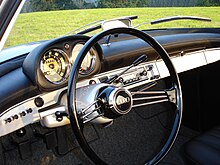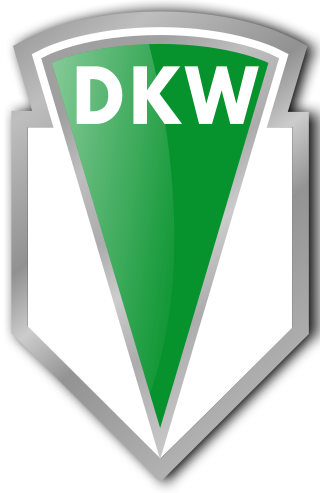
DKW was a German car- and motorcycle-marque. DKW was one of the four companies that formed Auto Union in 1932 and thus became an ancestor of the modern-day Audi company.

The Ford Köln is an automobile that was produced by Ford Germany from 1933 until 1936 at its Cologne plant.

Auto Union AG, was an amalgamation of four German automobile manufacturers, founded in 1932 and established in 1936 in Chemnitz, Saxony. It is the immediate predecessor of Audi as it is known today.

Horch was a car manufacturer, founded in Germany by August Horch & Cie at the beginning of the 20th century.

The Mercedes-Benz W111 was a chassis code given to a range of Mercedes-Benz vehicles produced between 1959 and 1971, including four-door saloons (1959-1968) and two-door coupés and cabriolets. Their bodywork featured distinctive tailfins that gave the models their Heckflosse nickname — German for "fintail".

The DKW F102 is a passenger car that was produced from August 1963 by the German manufacturer Auto Union. Superseding the Auto Union 1000, it was the last model branded as a DKW by the manufacturer and also one of the last West German production car equipped with a two-stroke engine, the last being the Goggomobil.

The Wartburg 353, known in some export markets as the Wartburg Knight, is a medium-sized family car, produced by the East German car manufacturer AWE for their Wartburg brand. It was the successor of the Wartburg 311, and was itself succeeded by the Wartburg 1.3.
Egon Brütsch Fahrzeugbau, usually shortened to Brütsch, was a German automotive design and automaker based in Stuttgart, Baden-Württemberg.

The Auto Union 1000 is a luxury compact front-wheel drive automobile manufactured by Auto Union GmbH between 1958 and 1969. It was the first model branded as an Auto Union by the manufacturer since the 1930s; it replaced the DKW 3=6, although the latter continued in production, until the end of 1959. The two cars were broadly similar, but the new car had its two-stroke engine enlarged to 981 cc yielding a 10% - 37% power increase.
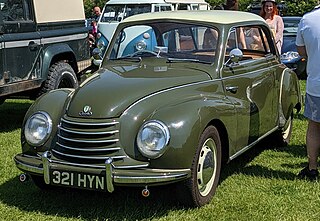
The DKW 3=6 is a compact front-wheel drive saloon manufactured by Auto Union GmbH. The car was launched at the Frankfurt Motor Show in March 1953 and sold until 1959. It carried the name Sonderklasse on the right hand fender of all steel bodied models - this being part of the model name for this range. The first model in the range was named by factory project number, DKW F91, which was replaced by the F93 and F94 models from the 1956 model year. The F93 and F94 models were referred to by Auto Union as the "Big DKW 3=6". From 1958, by which year the car's successor, the Auto Union 1000 Coupe de Luxe, was already being sold and the earlier version had therefore become, in essence, a ‘run-out’ model, it was known more simply as the DKW 900.

The DKW Meisterklasse, also known as the DKW F89, is a compact front-wheel drive saloon manufactured by Auto Union GmbH between 1950 and 1954. It was the first passenger car to be manufactured by the new Auto Union company in West Germany following the re-establishment of the business in the west in 1949.

The DKW F8 is a compact front-wheel drive two-stroke engined saloon, introduced in 1939. The F8 was slightly shorter than its predecessor despite having a marginally increased wheelbase. The base model, known as the Reichsklasse, was manufactured only till 1940 but the Meisterklasse sedan continued in production until 1942. In addition to the saloons, cabriolet versions were offered.

The DKW Junior is a small front wheel drive saloon manufactured by Auto Union AG. The car received a positive reaction when first exhibited, initially badged as the DKW 600, at the Frankfurt Motor Show in March 1957. The ‘Junior’ name was given to the DKW 750 in 1959 when the car went into volume production, but failed to survive an upgrade in January 1963, after which the car was known as the DKW F12. In addition to the saloon, a pretty ‘F12 Roadster’ was produced in limited numbers.

The DKW F5 is a sub compact front wheel drive saloon launched by Auto Union's DKW division in 1935 as a replacement for the DKWs F4 (Meisterklasse) and F2 (Reichsklasse) models.

From 1931 to 1939, Daimler-Benz AG produced three cars with rear engine as well as a few prototypes. The production numbers remained quite low for each of these models, especially compared to the production of classical front-engine Mercedes cars.

The Institec Justicialista was a line of cars produced by the government of Argentina via IAME from 1954 to 1955 as an attempt to develop a native Argentine automotive industry. It used a front-engine, front-wheel-drive layout with a two-stroke two-cylinder engine derived from a German DKW design and a conventional metal body. Due to the insistence of General Juan Domingo Perón a sports car prototype was made, a two-seat version was showcase as roadster in the Paris Motor Show. The prototype was repurposed Porsche with a fiberglass body powered by a 1.5-liter air-cooled Porsche flat-four engine and a Porsche four-speed gearbox driving the front wheels.

The Audi Type P was a small two-door sedan/saloon car introduced by Audi in 1931. It was discontinued by 1932.
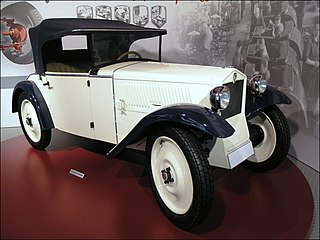
The DKW F1 was a small car produced by DKW between 1931 and 1932. It was launched at the Berlin Motor Show in February 1931.
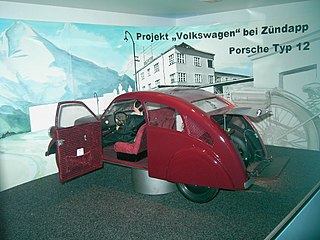
The Porsche Type 12 was a German project to develop an "Everyman's automobile" for Zündapp. Fritz Neumeyer, then owner of Zündapp, ordered Ferdinand Porsche to design and build the prototype in 1931. Eventually, two saloons, and one drophead coupé were built. All of those cars were lost during World War II, the last one in a bombing raid in Stuttgart in 1945. The Type 12 is considered an important early step in the development of the original Volkswagen. A replica of the Type 12 is on static display at the Museum Industrielkultur in Nürnberg.
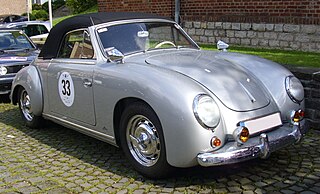
Dannenhauer & Stauss was founded by Gottfried Dannenhauer, a German coachbuilder. He had been employed by Karosseriewerk Reutter based in Stuttgart. Whilst there, he was communicating with Volkswagen before World War II. From 1950 to 1957 Reutter manufactured about 100 convertibles, mostly based on the Volkswagen Beetle. The sales price was 8,892 DM. The body was handmade by tapping metal sheets on a template. The doors were made in a pressing shop. Other companies like DKW were supplied. When in 1955 the Karmann Ghia was mass-produced, the company could no longer compete, and its product was discontinued. The amount of production was limited, but precise numbers are uncertain. Changing their business model to rebuilding vehicle bodies allowed the company to survive at the address in Augustenstraße, Stuttgart where Reutter had been.


